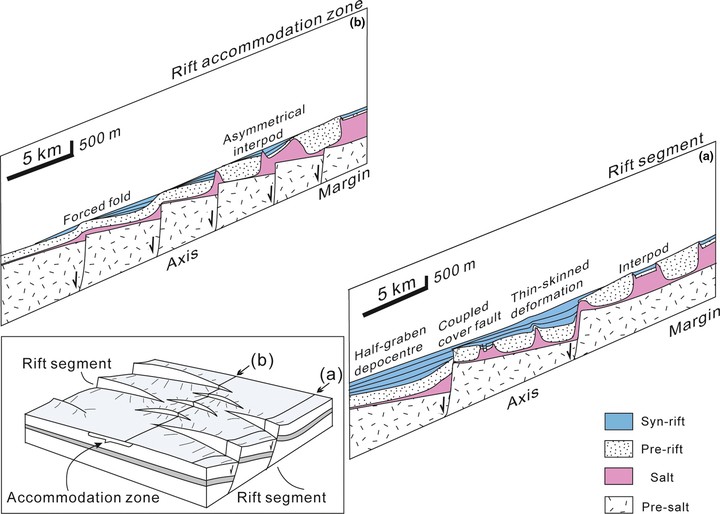Impact of normal faulting and pre‐rift salt tectonics on the structural style of salt‐influenced rifts: the Late Jurassic Norwegian Central Graben, North Sea
 The style and distribution of syn‐rift depocentres in a typical salt‐influenced rift comprising rift segments and rift accommodation zones
The style and distribution of syn‐rift depocentres in a typical salt‐influenced rift comprising rift segments and rift accommodation zones摘要
Studies of salt‐influenced rift basins have focused on individual or basin‐scale fault system and/or salt‐related structure. In contrast, the large‐scale rift structure, namely rift segments and rift accommodation zones and the role of pre‐rift tectonics in controlling structural style and syn‐rift basin evolution have received less attention. The Norwegian Central Graben, comprises a complex network of sub‐salt normal faults and pre‐rift salt‐related structures that together influenced the structural style and evolution of the Late Jurassic rift. Beneath the halite‐rich, Permian Zechstein Supergroup, the rift can be divided into two major rift segments, each comprising rift margin and rift axis domains, separated by a rift‐wide accommodation zone – the Steinbit Accommodation Zone. Sub‐salt normal faults in the rift segments are generally larger, in terms of fault throw, length and spacing, than those in the accommodation zone. The pre‐rift structure varies laterally from sheet‐like units, with limited salt tectonics, through domains characterised by isolated salt diapirs, to a network of elongate salt walls with intervening minibasins. Analysis of the interactions between the sub‐salt normal fault network and the pre‐rift salt‐related structures reveals six types of syn‐rift depocentres. Increasing the throw and spacing of sub‐salt normal faults from rift segment to rift accommodation zone generally leads to simpler half‐graben geometries and an increase in the size and thickness of syn‐rift depocentres. In contrast, more complex pre‐rift salt tectonics increases the mechanical heterogeneity of the pre‐rift, leading to increased complexity of structural style. Along the rift margin, syn‐rift depocentres occur as interpods above salt walls and are generally unrelated to the relatively minor sub‐salt normal faults in this structural domain. Along the rift axis, deformation associated with large sub‐salt normal faults created coupled and decoupled supra‐salt faults. Tilting of the hanging wall associated with growth of the large normal faults along the rift axis also promoted a thin‐skinned, gravity‐driven deformation leading to a range of extensional and compressional structures affecting the syn‐rift interval. The Steinbit Accommodation Zone contains rift‐related structural styles that encompass elements seen along both the rift margin and axis. The wide variability in structural style and evolution of syn‐rift depocentres recognised in this study has implications for the geomorphological evolution of rifts, sediment routing systems and stratigraphic evolution in rifts that contain pre‐rift salt units.